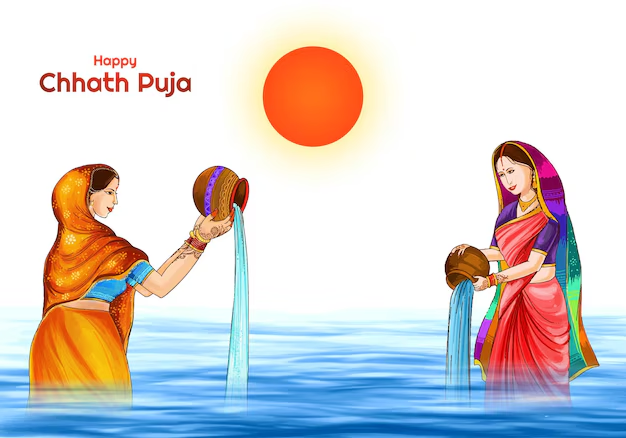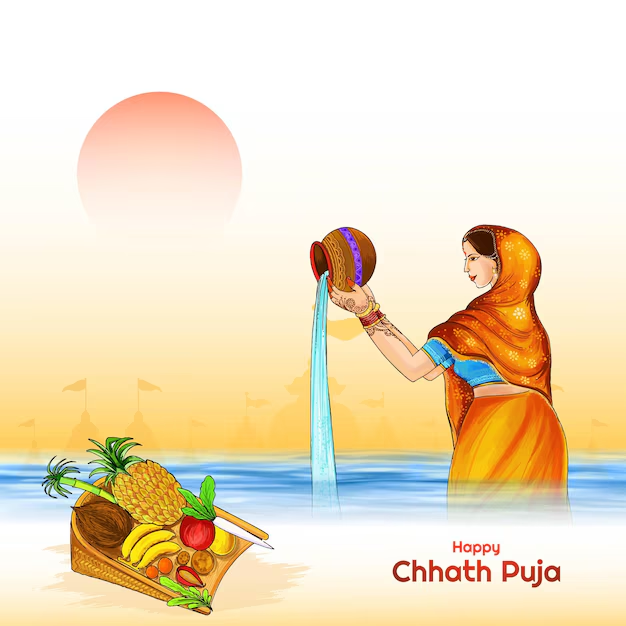Chhath Puja is a sacred festival celebrated in regions of Bihar, Uttar Pradesh, Jharkhand, and parts of Nepal, dedicated to the worship of the Sun God (Surya) and Chhathi Maiya. This festival, which lasts four days, is known for its intense rituals and fasting practices, symbolizing purity, humility, and respect for nature. One of the defining aspects of Chhath Puja is its focus on eco-friendly practices, as devotees use natural ingredients and biodegradable materials for rituals.
A significant component of Chhath Puja is the traditional foods and offerings, which are carefully prepared as part of the prayers. These foods, often simple yet full of meaning, reflect the values of devotion and gratitude. From Thekua to fruits and other delicacies, each item used in Chhath Puja holds cultural and spiritual importance. These offerings signify a return to simplicity and sustainability, emphasizing respect for both nature and tradition.
Traditional Foods Prepared for Chhath Puja
Chhath Puja’s traditional foods are as diverse as they are meaningful. Each item prepared during this festival embodies values of devotion and simplicity and is prepared without onion, garlic, or any processed ingredients. The foods are considered prasad (sacred offerings), given to the deities and then shared among family and friends, symbolizing unity and gratitude. Let’s explore the key foods that are central to Chhath Puja.
Thekua: The Signature Sweet of Chhath Puja
Thekua is the quintessential sweet of Chhath Puja. Made from wheat flour, jaggery (unrefined cane sugar), and ghee, Thekua has a unique, rich taste and a crunchy texture. It is shaped into round or oval patties and often imprinted with floral patterns using molds. This sweet treat symbolizes purity and is made without any artificial ingredients, making it both delicious and environmentally friendly.
The process of making Thekua is a communal activity, bringing families and friends together as they prepare the batter, shape the sweets, and fry them to a golden brown. Thekua represents the simplicity of rural life and the idea of sustainability, as it is made using basic ingredients easily sourced from local agriculture. This sweet offering also reflects a sense of gratitude for the harvest season, as its ingredients come from the land itself, emphasizing the importance of nature in sustaining human life.
Kheer: Symbolizing Purity and Devotion

Kheer, a sweet rice pudding made with milk, rice, and sugar, is another important offering during Chhath Puja. Unlike festive versions with added nuts and spices, the Chhath Puja kheer is made simply to preserve its purity. Kheer symbolizes prosperity and is considered a nourishing, sacred food, believed to cleanse the body and soul.
This dish is often made on the second day of Chhath Puja as a meal to break the day-long fast, shared by family members in a ritual known as Kharna. Kheer represents abundance, as rice and milk are symbols of sustenance and vitality in Indian culture. Preparing and sharing Kheer reinforces the communal aspects of Chhath Puja, reminding participants of the strength found in unity and shared traditions.
Rice and Wheat Delicacies: Celebrating Abundance
In addition to Thekua and Kheer, rice and wheat play a central role in Chhath Puja offerings. Many households prepare items like rice laddus and puris (fried wheat bread) as prasad for the rituals. These grains are symbolic of prosperity and are chosen for their connection to agriculture, which sustains the livelihoods of millions in India.
Offering these grains during Chhath Puja is a way of expressing gratitude to the Earth and honoring the gifts of nature. As rice and wheat are both staple crops, their inclusion in the rituals signifies a celebration of life’s essentials. The simple act of using basic grains as prasad encourages mindfulness about sustainability and respect for the food that sustains us.
Significance of Each Offering in Chhath Puja
Each food offered during Chhath Puja is not just a meal but a deeply symbolic act. Thekua, Kheer, and various fruits represent purity, gratitude, and reverence for the natural world. The offerings reflect a sustainable lifestyle that values simplicity over excess. These foods remind devotees of the festival’s core message: to live in harmony with nature and honor its bounty.
The offerings are also a tribute to the Sun God, symbolizing energy, health, and life. By offering food made from natural ingredients, Chhath Puja practices promote ecological consciousness, encouraging communities to use resources responsibly. Every food item prepared for Chhath Puja represents a step towards a spiritually and environmentally balanced life.
Eco-Friendly Offerings in Chhath Puja
Chhath Puja is unique in its emphasis on eco-friendly practices, setting an example for sustainable celebrations. Devotees use locally sourced fruits, biodegradable containers like bamboo baskets, and banana leaves to carry prasad. This conscious effort to use natural materials reduces waste and minimizes environmental impact, reflecting the festival’s commitment to eco-friendly traditions.
The focus on sustainable offerings in Chhath Puja aligns with the festival’s core values of humility and respect for nature. This aspect of the festival highlights the importance of adopting greener practices in every aspect of life, encouraging participants to appreciate and conserve natural resources. Through these practices, Chhath Puja promotes a legacy of responsible celebration and ecological awareness.
How Families and Communities Come Together in Chhath Puja Preparations
Chhath Puja is not only about individual devotion but also about bringing families and communities closer. Preparation begins days in advance, with family members coming together to make sweets, clean the house, and prepare for the rituals. The communal nature of the festival is reflected in the way people share food, help each other, and pray together at riverbanks or ponds.
Community gatherings at dawn and dusk are common, where entire neighborhoods congregate to perform the rituals. This communal aspect fosters a sense of belonging and unity, reminding everyone of the power of togetherness in faith and tradition. Celebrating Chhath Puja collectively strengthens social bonds and preserves cultural heritage.
Conclusion: Celebrating Chhath Puja with Traditional Foods and Offerings
Chhath Puja is a celebration of simplicity, devotion, and environmental respect. The traditional foods like Thekua, Kheer, and local grains represent more than sustenance—they embody values of gratitude, purity, and ecological harmony. Through these offerings, devotees express a profound connection to the Earth and its resources.
As we celebrate Chhath Puja each year, the emphasis on natural and sustainable practices serves as a reminder of our responsibility to protect the environment. This festival is a testament to the enduring power of tradition, encouraging us to cherish the values of respect, unity, and gratitude in every aspect of life.


